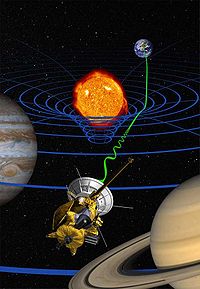Portal:Physics/Selected article/September 2007

- Introduction to general relativity provides a generally accessible introduction to the subject. For the main encyclopedia article, please see General relativity.
General relativity (GR) is a theory of gravitation that was developed by Albert Einstein between 1907 and 1915. According to general relativity, the observed gravitational attraction between masses results from those masses warping nearby space and time. Previously, Newton's law of universal gravitation (1686) had described gravity as a force between masses, but experiments have shown that Einstein's description is more accurate. What is more, general relativity predicts interesting new phenomena such as gravitational waves.
General relativity accounts for several effects that are unexplained by Newton's law, such as minute anomalies in the orbits of Mercury and other planets, and it makes numerous predictions – since confirmed – for novel effects of gravity, such as the bending of light and the slowing of time. Although general relativity is not the only relativistic theory of gravity, it is the simplest such theory that is consistent with the experimental data. However, a number of open questions remain; the most fundamental is how general relativity can be reconciled with the laws of quantum physics to produce a complete and self-consistent theory of quantum gravity.
The theory has developed into an essential tool for modern astrophysics. It provides the foundation for our current understanding of black holes; these are regions of space where gravitational attraction is so strong that not even light can escape. Their strong gravity is thought to be responsible for the intense radiation emitted by certain types of astronomical objects (such as active galactic nuclei or microquasars).
The bending of light by gravity can lead to the curious phenomenon of multiple images of one and the same astronomical object being visible in the sky. This effect is called gravitational lensing, and its study is an active branch of astronomy. Direct evidence of gravitational waves is being sought by several teams of scientists, as in the LIGO and GEO 600 projects; success should allow scientists to study a variety of interesting phenomena, from black holes to the early universe, by analyzing the gravitational waves they produce. General relativity is also the basis of the standard Big Bang model of cosmology.
- Image: High-precision test of general relativity by the Cassini space probe (artist's impression): radio signals sent between the Earth and the probe (green wave) are delayed by the warping of space and time (blue lines).
